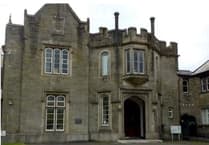SOME think of Halloween as a fad imported from America, but in Cornwall and the other Celtic lands October 31 has ancient customs linked to it.
Some folklorists think these customs contain hints of the Roman feast of Pomona, goddess of fruits and seeds, but Halloween is more usually linked to the Celtic festival of Samhain (pronounced ‘Sawin’), a word derived from the Old Irish for ‘summer’s end’. Indeed, there is evidence the Halloween tradition was taken to America by Irish and Scots immigrants.
In the medieval Gaelic calendar, Samhain was celebrated on October 31-November 1 in Ireland, Scotland and the Isle of Man – but Cornwall had its equivalent called Kalan Gwav, meaning ‘the first day of winter’ (and also called Calan Gaeaf in Wales and Kalan Goanv in Brittany).
These traditions are mentioned in early Irish and Welsh texts as marking the end of the harvest season and the beginning of the darker half of the year.
The supernatural element we enjoy today comes from the Celtic belief that it was a time when the boundary between this world and the ‘Otherworld’ of spirits was thinned, so it was when the Irish ‘Aos Si’ (pronounced ‘eess-Shee’) fairy folk and the piskies (or pixies) of Cornish and Dartmoor tradition were mixing in the world of humans. People fearful of the mischief they might cause would leave out offerings of food and drink, or crops, in an attempt to keep them ‘on side’.
It was also believed that the souls of the dead might revisit their old homes to seek hospitality, so extra places would be set at table or by the fire to welcome them, and candles would be lit to remember them. Elsewhere in Europe, such as in Poland, it is traditional to visit graves of loved ones and light candles at this time of the year.
With the coming of Christianity, the Celtic pagan traditions associated with Kalan Gwav and Samhain were absorbed and adapted into the church calendar. The name ‘Hallowe’en’ actually has Scottish roots, as a dialect contraction of All Hallows Eve, but in Wales and the Isle of Man it was known as Hollantide.
Cornwall had its own title of Allantide, or the Feast of St Allan, after it became associated with a 6th-century bishop of Quimper in Brittany, a region of north-west France which has a Celtic language similar to Cornish.
The evening would see church bells run to comfort Christian souls in Purgatory, and people would give glossy red ‘Allan apples’ to family members and friends as a token of good luck.
In West Cornwall, shops were still stocking polished apples up to the early 19th century – and children regarded it as a misfortune if they had to go to bed on Allantide without apples under their pillows.
Older girls also believed that placing apples under their pillows would result in them dreaming of the man they would one day marry – and other divination games saw walnuts being thrown into the fire to predict how faithful a partner would be, and pouring molten lead into cold water to somehow predict the future occupation of husbands from the shapes the solidified metal formed.
Another Cornish game was to nail two pieces of wood together in the shape of a cross, then suspend it horizontally from the ceiling and attach four lit candles to each arm of the cross. Apples on strings would then be suspended from this structure and members of the household would try to catch the apples in their mouths – hot wax from the candles being the penalty for slowness. Today apple bobbing is somewhat safer and involves apples floating in a bowl of water instead.
Turnip lanterns – also known as jack o’lanterns – seem to have been adopted after the introduction of this useful soil-improving vegetable in the 19th century, and today are being supplanted by the easier-to-carve American pumpkin.
As for today’s trick or treating, it has its origins in the medieval practice of ‘guising’, whereby masked people in fancy dress would go from house to house asking for ‘soul cakes’ in return for saying prayers for the souls of the dead.
Today we are a lot less serious about it all and the custom is just all about fun.
GARDEN FRIGHTS:
STEP into your garden this Halloween and you might find some spooky spikes, noxious nasties and creepy creepers lurking in your borders. Get yourself into the mood with this guide to horticultural horrors...
1. Eye-poppers – This plant with spooky white berries and a single black spot emerging from red stems is nicknamed the Doll’s Eye (Actaea pachypoda). All parts of it are poisonous and when ingested can cause hallucinations.
2. Strangling suspects – Also known as strangleweed, devil’s guts, witches’ shoelaces and devil’s ringlet, dodder (Cuscuta), a relative of bindweed, twines itself round a host plant, sucks out everything it needs to live and kills its host in the process.
3. Prickly subjects – Among the most prickly of plants is the hawthorn. As a thorny hedge, it will stab its thorns into your fingers, but can also help to deter burglars.
4. Toxic terrors – Aconitum, also known as monkshood or wolfsbane, is among the most toxic of plants, with ingestion of even a small amount causing severe stomach upsets and a slow heart rate.
5. Poisonous potions – Hemlock is highly poisonous and closely linked with witchcraft but it doesn’t look significantly different from the hedge parsley or cow parsley which grows along roadsides in summer.
Deadly nightshade (Belladonna), another common plant found in hedgerows, was said to be an ingredient in witches’ brews in the Middle Ages, while blackthorn is referred to as a witch’s tree.
6. Warding off evil – Plants including rowan (Sorbus aucuparia), hazelnut (Corylus avellane) and elderberry (Sambucus nigra) were once thought ‘magical’ trees and shrubs, which could ward off witches and evil spirits.
Ancient Celts believed rowan berries gave good health, and if you planted them near grave sites, they would help the dead sleep. People would use branches as dowsing rods and make crosses of rowan twigs to protect themselves on Halloween.


.jpg?width=209&height=140&crop=209:145,smart&quality=75)

